What to do if Croton leaves fall?

Croton has long and rightfully won the hearts of flower growers. This is an amazingly beautiful plant with a bright unusual color of leaves, which reaches a meter in height in several years. In addition, this flower is very unpretentious. Probably the only problem faced by its owners is yellowing and discoloration of the leaves.

Causes of yellowing leaves
The homeland of Croton is Oceania and the countries of Southeast Asia, where it grows in tropical forests, which is why it is very important for domestic crotons to maintain comfortable living conditions with warm air and high humidity. This plant requires moderate watering, regular replanting, and a fertilized substrate. The flower is picky about lighting, it does not tolerate any drafts.
Any unfavorable change in the habitat immediately causes a negative reaction of croton - it begins to turn yellow and throw off the leaves. Nevertheless, in the vast majority of cases, a green pet can be saved if timely measures are taken to revive and restore it.
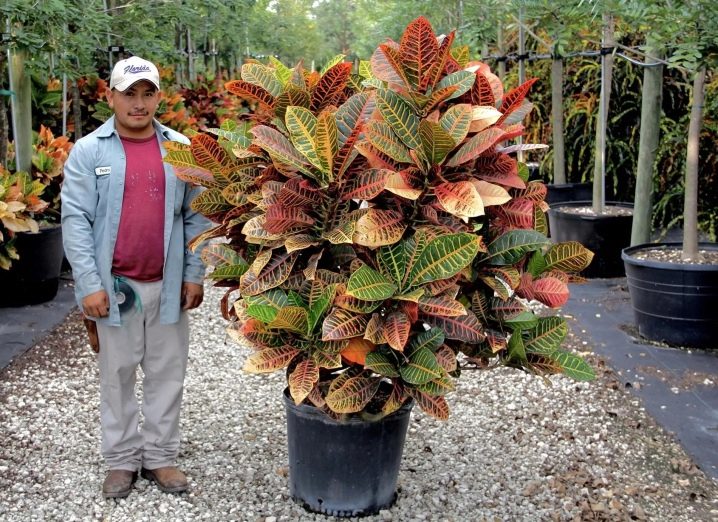
Watering
Most often, croton sheds leaves due to a violation of the irrigation regime. Like most tropical exotic plants, he prefers humidified air and good irrigation, which is why it is important to carefully monitor the condition of the soil - it must be constantly moistened. This is true both in summer, when the weather is hot outside, and in winter, when heating is working in the living quarters.
This green pet reacts instantly to the dryness of the earthen coma: the lower leaves fall, turn yellow and fall off rather quickly, at best only the top will remain of the leaf mass, most often the leaves fall off completely.
To prevent the leaves from falling off, you should water the flower as needed.
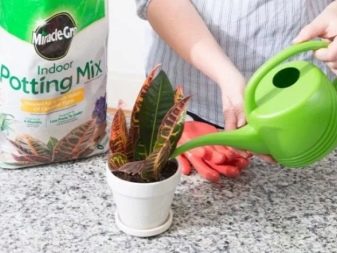
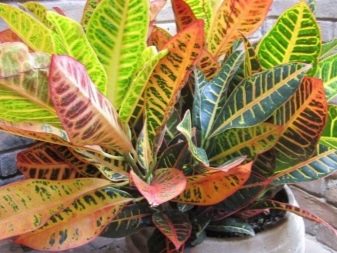
If your plant is large, then you can water it daily, but little by little. However, do not overdo it, moisture stagnation should not be allowed: in this case, the root system will begin to rot, and the aboveground part will not receive the required volume of water and nutrients, which can also cause leaves to fall.
To avoid waterlogging of the soil, when planting croton, you need to pay special attention to drainage - usually expanded clay or gravel is used for this, the layer of which should be at least 1/4 of the total volume of the pot.
It is very important that croton receives moisture not only from the ground, but also from the leaves - the plant responds well to spraying its crown from a spray bottle, you can also wipe the leaf plates with a sponge from time to time and have a warm shower once a month.
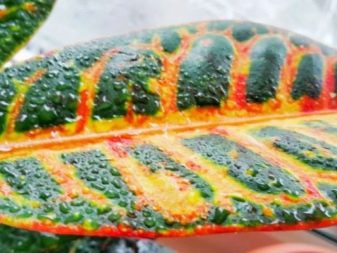
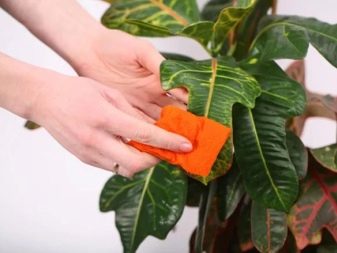
Temperature and humidity
When keeping croton, maintaining a comfortable temperature is of particular importance - do not forget that this is a native of the tropics, so any decrease in temperature will be disastrous for him. If the air in the room is colder than +14 degrees, then all necessary life processes begin to slow down to such an extent that the tips of the croton leaves begin to dry out and soon disappear altogether.
If the temperature stays above + 25 degrees, especially in combination with dry air, the foliage drops, and this is a clear indication that the plant has begun to wither due to improper keeping conditions. Too hot air is no less dangerous for croton, but it can always be compensated for by high humidity. - in cold air, the situation can be corrected only by moving the flower to a warmer room.
The optimal environment for keeping croton is considered to be air with a temperature background of + 20-24 degrees. In the warm season, you can take the plant out to the balcony, porch or terrace - this will improve its immunity, however, it is important to prevent direct ultraviolet rays from acting on it.

Location
Very often crotons turn yellow because they are located in the wrong place. Experienced flower growers know that the slightest draft can destroy this plant, so it is best to place a flowerpot with a croton in a corner, in a place where there is no movement of air masses - near the door or near the window.
If the plant is small, then the edge of the window sill is fine.
It is also important not to allow direct sunlight: Croton prefers diffused lighting, so it is best for the flower habitat to choose a window sill in the east and west directions, there will be little light on the north side of the croton, and in the south the sun is too active for him.
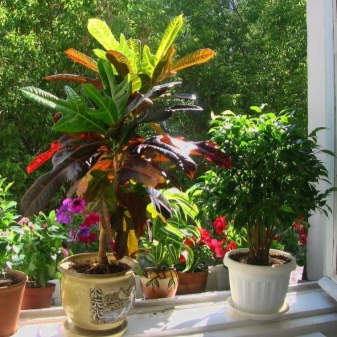
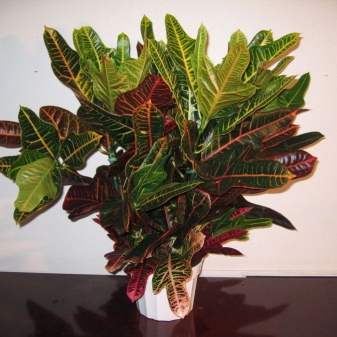
Top dressing
In conditions of a lack of nutrients, Croton dries up and loses leaves. Ideally, you should prepare versatile substrate for indoor plants with dense foliage - it can be purchased from a specialist store.
Every two weeks during the period of active growth from March to November, it is necessary to do top dressing - to make complex mineral supplements, and in winter it will be enough only once a month.
Croton responds very well to irrigation with water with the addition of 3% hydrogen peroxide - 2 tablespoons of the drug are taken for one liter of liquid. This solution contributes to better oxygenation of the roots.

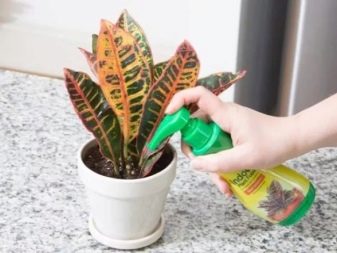
Diseases and pests
The cause of the yellowing and dropping of its leaves by croton is often a plant disease or an attack of insect pests.
Of the diseases, most often the culture is faced with the following problems.
- Anthracnose - in this case, reddish and ash-gray spots of arbitrary shape are formed on the leaves, soon after their appearance, the leaves begin to fall off.
The diseased plant must be isolated, then transplanted into a new substrate and a new pot, and then sprayed with special preparations. The most effective are "Kumulus", "Fundazol" and "Euparen".
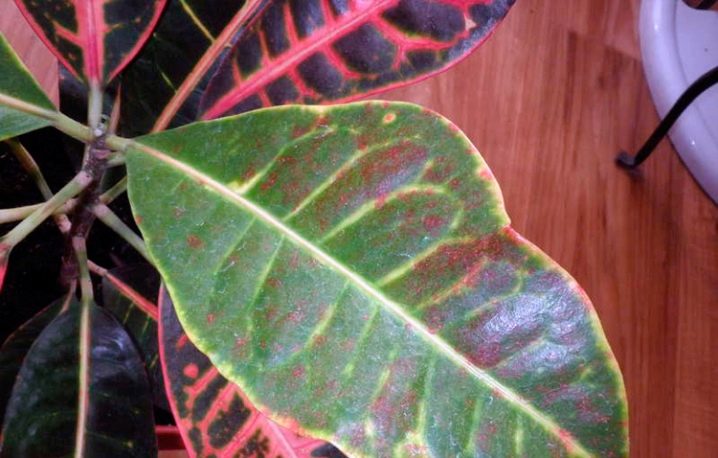
- Root rot - yellowing and pallor of the leaves is considered the very first sign indicating such a disease. If you dig up the plant, you will notice that the roots have begun to rot - this happens due to the low acidity of the soil.
To reanimate your green pet, you should cut off all the affected areas, transplant the plant into nutrient soil and water it with Fitosporin or Alirin-B fungicides under the root.
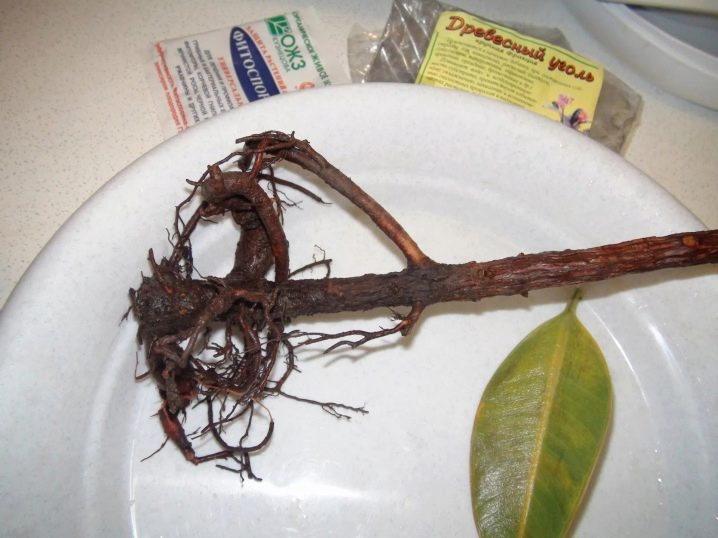
Of the pests, the following parasites cause the greatest harm to croton.
- Spider mite - this is a spider of very small size, which is rather difficult to detect with the naked eye, but its appearance can be judged by the gray-silver thinnest cobwebs on the back of the leaf. The parasite sucks out the plant's vital juices, which leads to its wilting. To get rid of the tick, it is necessary to wash the leaf plates and young green stems with tobacco infusion with the addition of laundry soap, or treat with special insecticides.
- Shield - This insect can be identified by the characteristic plaques on the inside of the leaves and stems. The danger of scale insects is that they multiply very quickly and can destroy even a large plant in the shortest possible time. You can save a flower by washing it with tobacco infusion or soapy water.
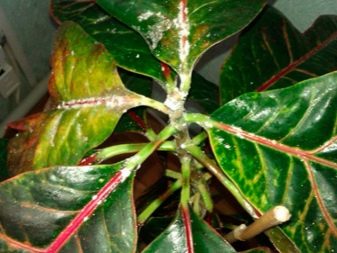
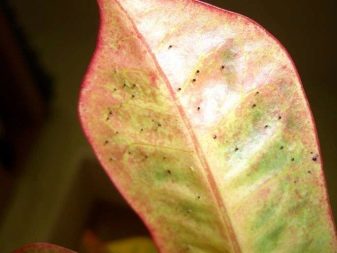
Prophylaxis
As the saying goes, disease is easier to prevent than to cure. And this also applies to maintaining the condition of our green pets.
In order not to face such an unpleasant problem as yellowing and shedding of leaves, you need to follow several recommendations:
- the plant must be provided with a sufficient amount of moisture and at the same time avoid excessive watering;
- it is important not only to moisten the soil, but also to regularly spray the plant;
- the pot must be located away from drafts;
- light soils are suitable for croton, with good drainage, high water and air permeability;
- the size of the container should be commensurate with the volume of the root system: if the roots are too crowded, then first of all the croton begins to shed its leaves;
- do not forget about regular feeding of the plant.
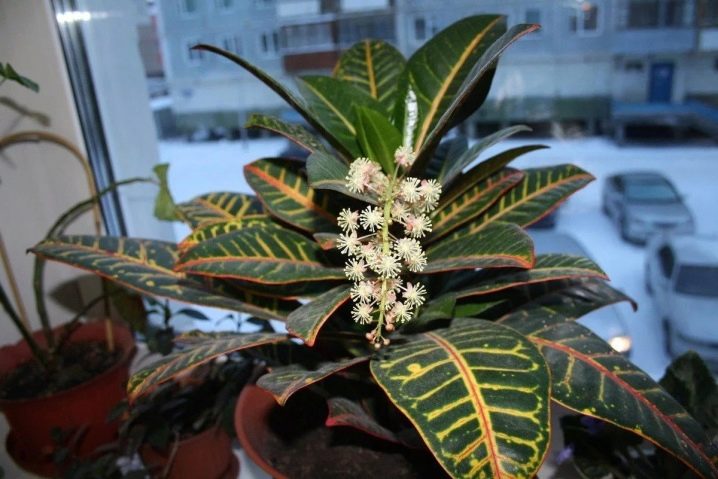
Croton is a rather refined, beautiful and variegated houseplant that can decorate a wide variety of interiors. It is distinguished by an unusual color and shape of the leaves, because when they crumble, this immediately affects the general appearance of the plant and seriously upsets the owners of the flower.
To prevent this from happening, you should follow the simple rules of caring for it - then your green pet will delight you with its spectacular appearance for many years.
What to do if croton leaves fall, see the video below.


























The comment was sent successfully.